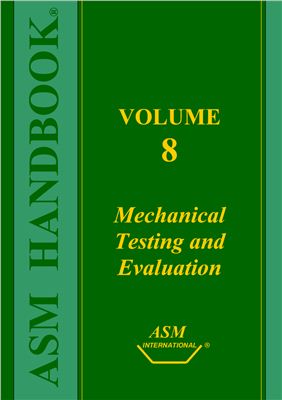ASM Inteational, 2002, 2235 p.
This revision of ASM Handbook, Volume 8 is intended to provide up-to-date, practical information on mechanical testing for metals, plastics, ceramics, and composites.
The first section, "Introduction to Mechanical Testing and Evaluation, " covers the basics of mechanical behavior of engineering materials and general engineering aspects of mechanical testing including coverage on the accreditation of testing laboratories, mechanical tests in metalworking operations, and the general mecahnical tests of plastics and ceramics.
The next three sections are organized around the basic modes of loading of materials: tension, compression bending, shear, and contact loads. The first four modes (tension, compression, bending, and shear) are the basic simple loading types for deterimation of bulk properties of materials under quasi-statis or dynamic conditions.
The third section, "Hardness Testing, " describes the various methods for indentation tesitng, which is a relatively inexpensive test of great importance in manufacturing quality control and materials science. This section includes new coverage on instrumented (nano-indentation) hardness testing and the special issues of hardness testing of ceramics. Following the section on hardness testing, the fourth section addresses the mechanical evaulation of surfaces in terms of adhesion and wear characteristics from point loading and contact loading. These methods, often in conjunction with hardness tests, are used to determine the response of surfaces and coatings to mechanical loads.
The next four sections cover mechanical testing under important dynamic conditions of slow strain rates (i.e. , creep deformation and stress relaxation), high strain rate testing, dynamic fracture, and fatigue. These four sections cover the nuances of testing materials under the basic loading types but with the added dimension of time as a factor. Very long-term, slow rate of loading (or unloading) in creep and stress relaxation is a key factor in many high-temperature applications and the testing of viscoelastic materials. On the opposite end of the spectrum, high strain rate testing characterizes material response during high-speed deformation processes and dynamic loading of products. Fracture toughness and fatigue testing are the remaining two sections covering engineering dynamic properties. These sections include coverage on the complex effects of temperature and environmental degradation on crack growth under cyclic or sustained loads.
Finally, the last section focuses on mechanical testing of some common types of engineering components such as gears, bearings, welds, adhesive joints, and mechanical fasteners. A detailed article on residual stress measurements is included, as residual stress from manufacturing operations can be a key factor in some forms of mechanical performance such as stress corrosion cracking and fatigue life analysis. Coverage of fiber-reinforced composites is also included as a special product form with many special and unique testing and evaluation requirements.
This revision of ASM Handbook, Volume 8 is intended to provide up-to-date, practical information on mechanical testing for metals, plastics, ceramics, and composites.
The first section, "Introduction to Mechanical Testing and Evaluation, " covers the basics of mechanical behavior of engineering materials and general engineering aspects of mechanical testing including coverage on the accreditation of testing laboratories, mechanical tests in metalworking operations, and the general mecahnical tests of plastics and ceramics.
The next three sections are organized around the basic modes of loading of materials: tension, compression bending, shear, and contact loads. The first four modes (tension, compression, bending, and shear) are the basic simple loading types for deterimation of bulk properties of materials under quasi-statis or dynamic conditions.
The third section, "Hardness Testing, " describes the various methods for indentation tesitng, which is a relatively inexpensive test of great importance in manufacturing quality control and materials science. This section includes new coverage on instrumented (nano-indentation) hardness testing and the special issues of hardness testing of ceramics. Following the section on hardness testing, the fourth section addresses the mechanical evaulation of surfaces in terms of adhesion and wear characteristics from point loading and contact loading. These methods, often in conjunction with hardness tests, are used to determine the response of surfaces and coatings to mechanical loads.
The next four sections cover mechanical testing under important dynamic conditions of slow strain rates (i.e. , creep deformation and stress relaxation), high strain rate testing, dynamic fracture, and fatigue. These four sections cover the nuances of testing materials under the basic loading types but with the added dimension of time as a factor. Very long-term, slow rate of loading (or unloading) in creep and stress relaxation is a key factor in many high-temperature applications and the testing of viscoelastic materials. On the opposite end of the spectrum, high strain rate testing characterizes material response during high-speed deformation processes and dynamic loading of products. Fracture toughness and fatigue testing are the remaining two sections covering engineering dynamic properties. These sections include coverage on the complex effects of temperature and environmental degradation on crack growth under cyclic or sustained loads.
Finally, the last section focuses on mechanical testing of some common types of engineering components such as gears, bearings, welds, adhesive joints, and mechanical fasteners. A detailed article on residual stress measurements is included, as residual stress from manufacturing operations can be a key factor in some forms of mechanical performance such as stress corrosion cracking and fatigue life analysis. Coverage of fiber-reinforced composites is also included as a special product form with many special and unique testing and evaluation requirements.

